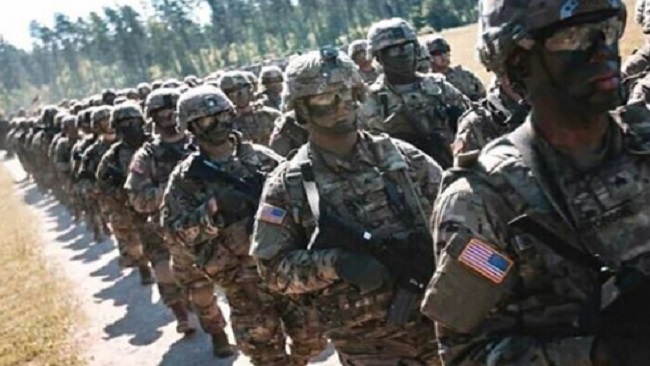Southern Cameroons Crisis: This photo does not show 3,500 US troops arriving in Cameroon
A picture shared hundreds of times in multiple Facebook posts claims to show 3,500 US troops arriving in Cameroon to replace Cameroonian soldiers in the English-speaking regions of the central African country. The claim is misleading; while the United States Africa Command confirmed the presence of some US troops in Cameroon, AFP established that the image was taken in Poland more than a year ago and depicts US soldiers marching during an annual international military exercise.
One of the posts, which we’ve archived, has racked up more than 83,000 views on Facebook, according to data provided by the social network. It shows US soldiers in military uniform marching in formation with firearms. The caption states: “3,500 American Troops Now in Cameroon.” It has been shared more than 720 times since it was first posted on December 15.
The picture was also shared and has been viewed more than 6,000 times according to Facebook data. This final version of the post tries to link two issues: the supposed US military presence in Cameroon, and the secession of Biafra from Nigeria on the other.
“The ultimatum given to President (Paul) Biya to immediately vacate his troops from Ambazonia tells you that America doesn’t care about sovereignty policy when it comes to defending the right of the oppressed people,” reads the caption, which was also shared alongside the picture in this post. “The world is very much interested in Biafra, giving us a home and a country will bring peace and reduce high rate of migration and possible Xenophobia rapidly spreading across Africa.”
Igbo separatists declared an independent republic of Biafra in 1967. More than one million people died in the two-and-a-half year civil war that followed.
The self-declared state ceased to exist after a final military defeat in 1970, but some groups including the Indigenous People of Biafra (IPOB), predominantly made up of Igbos from southeast Nigeria, continue to call for a separate homeland over alleged marginalisation. IPOB was designated a “terrorist” organisation by the Nigerian authorities in 2017.
Cameroon crisis
Cameroon’s Northwest Region and Southwest Region — home to a large minority of anglophones in the largely francophone country — have been gripped by violence since October 2017 when separatist leaders issued a symbolic declaration of independence, triggering a crackdown by security forces.
More than 3,000 people have died because of the conflict, and more than 500,000 people have fled their homes, according to the International Crisis Group.
Are US troops in Cameroon?
The short answer is that US troops have recently been deployed in Cameroon, but details are thin on the ground. US Africa Command (Africom), which coordinates US military operations in Africa, told us 160 troops had been sent to Cameroon “in support of a routine theater security cooperation event”, but did not tell us when or clarify whether they were still on the ground.
Separately, Africom spokeswoman Lieutenant Christina Gibson told AFP that US troops were in Cameroon “to conduct standard security cooperation activities, which are coordinated with the Cameroonian government for its concurrence,” while “the recent movement of a small number of US forces and aircraft was in support of a routine logistics movement”.
What about the photo?
Multiple Google reverse image searches helped AFP to trace the picture of the soldiers to the archives of the Defense Visual Information Distribution Service (DVIDS), a resource for media following US military issues.
The photo, which was published, was taken in a multinational formation involving troops from the United States, the United Kingdom, Romania, Croatia and Poland during the opening ceremony of Saber Strike 18 at Wierzbiny, Poland on June 4, 2018. The photo was credited to Specialist Hubert Delany of the US Army.
AFP went through the comments on the post and tracked Delany’s Facebook account where he displays the same picture as his header.
An analysis of the picture using INVID, a verification tool which AFP helped to develop, showed that Delany took the picture on February 5, 2019 — more than ten months before the claim surfaced on social media.
Culled from AFP





